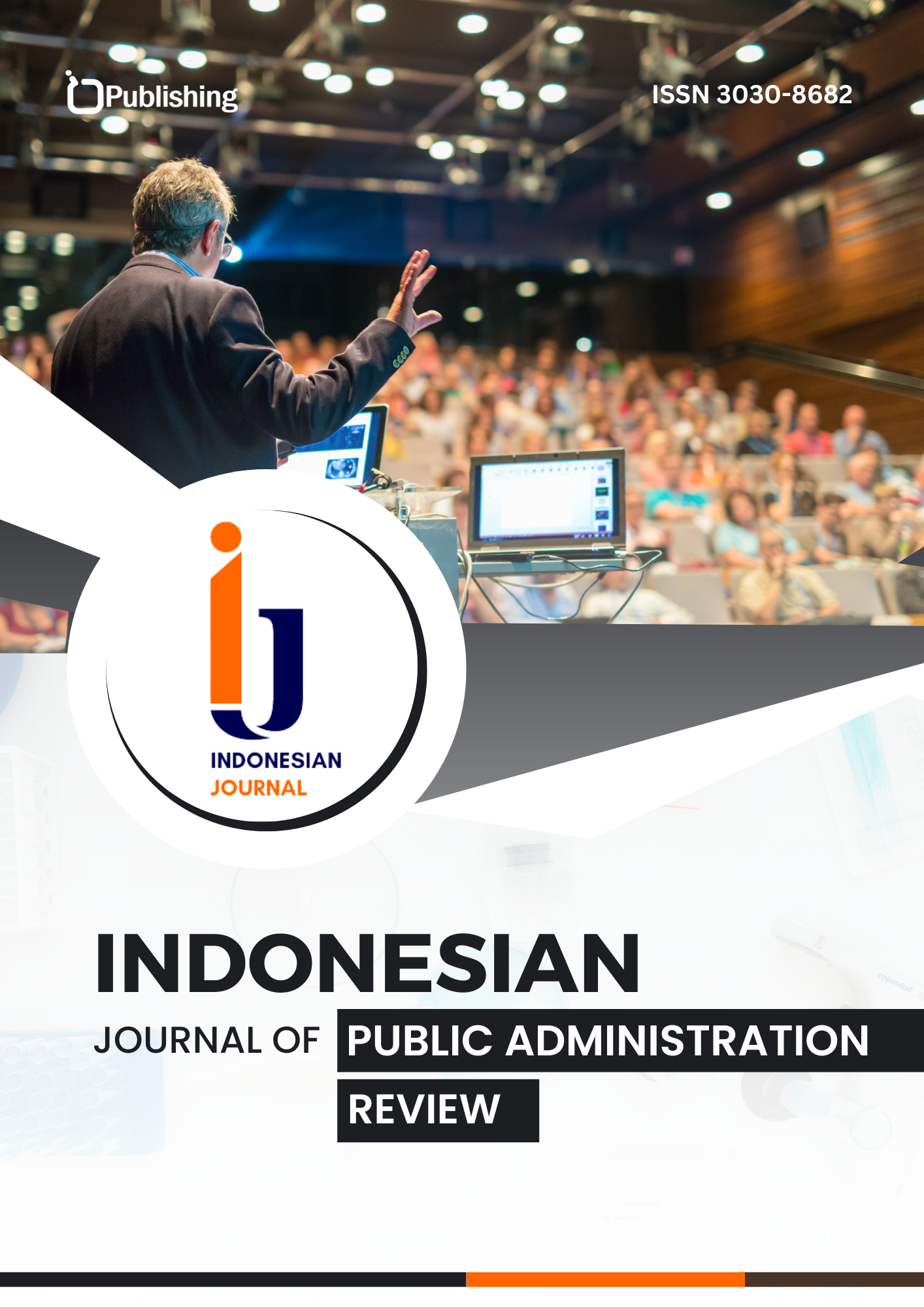Strengthening Defense Bureaucracy to Enhance the Implementation of Technology-Driven Defense
DOI:
https://doi.org/10.47134/par.v2i2.3420Keywords:
Decentralization, Defense Bureaucracy, Leadership Practices, Policy Reform, Technology IntegrationAbstract
In the rapidly changing defense and security environment, integrating technology into defense bureaucracies presents significant challenges. This study examines these challenges and explores strategies to overcome them, focusing on leadership practices and decentralization to improve efficiency. Utilizing qualitative methods and secondary data, including policy documents and expert analysis, the research identifies key obstacles such as institutional resistance, digital illiteracy, outdated infrastructure, and cybersecurity risks. The study emphasizes the importance of fostering a culture of innovation, upgrading infrastructure, and implementing strong cybersecurity measures. Transformational leadership is highlighted as crucial for driving bureaucratic change and overcoming resistance. Decentralization is also vital, enhancing decision-making by empowering lower-level managers. Effective decentralization requires clear guidelines, communication channels, and technology investments. The findings stress the need for continuous reform and strategic investments to ensure defense bureaucracies are aligned with modern technological demands.
References
Adana, S., Manuj, I., Herburger, M., Cevikparmak, S., Celik, H., & Uvet, H. (2024). Linking decentralization in decision-making to resilience outcomes: a supply chain orientation perspective. The International Journal of Logistics Management, 35(1), 256–280.
AL-Hawamleh, A. (2024). Cyber resilience framework: Strengthening defenses and enhancing continuity in business security. International Journal of Computing and Digital Systems, 15(1), 1315–1331.
Altamimi, H., Liu, Q., & Jimenez, B. (2023). Not too much, not too little: Centralization, decentralization, and organizational change. Journal of Public Administration Research and Theory, 33(1), 170–185.
Antal, C., Cioara, T., Anghel, I., Antal, M., & Salomie, I. (2021). Distributed ledger technology review and decentralized applications development guidelines. Future Internet, 13(3), 62.
Anurogo, D., La Ramba, H., Putri, N. D., & Putri, U. M. P. (2023). Digital Literacy 5.0 to enhance multicultural education. Multicultural Islamic Education Review, 1(2), 109–179.
Barbaroux, P. (2020). The transformation of the defense innovation system: knowledge bases, disruptive technologies, and operational capabilities. Systemic Innovation. Entrepreneurial Strategies and Market Dynamics.
Birkinshaw, J. (2018). How is technological change affecting the nature of the corporation? Journal of the British Academy, 6(s1), 185–214.
Bunjak, A., Bruch, H., & Černe, M. (2022). Context is key: The joint roles of transformational and shared leadership and management innovation in predicting employee IT innovation adoption. International Journal of Information Management, 66, 102516.
Cabrera, Á., Cabrera, E. F., & Barajas, S. (2008). The key role of organizational culture in a multi-system view of technology-driven change. In Global Information Systems (pp. 178–199). Routledge.
Calcaterra, C., & Kaal, W. (2021). Decentralization: Technology’s impact on organizational and societal structure. Walter de Gruyter GmbH & Co KG.
Chaumon, M.-E. B. (2021). Digital transformations in the challenge of activity and work: Understanding and supporting technological changes. John Wiley & Sons.
Clinton, H. (2020). A National Security Reckoning: How Washington Should Think About Power. Foreign Aff., 99, 88.
Creswell, J. W. (2014). Research Design: Qualitative, Quantitative, and Mixed Methods Approaches. SAGE Publications. https://cumming.ucalgary.ca/sites/default/files/teams/82/communications/Creswell%202003%20-%20Research%20Design%20-%20Qualitative%2C%20Quantitative%20and%20Mixed%20Methods.pdf
Dick-Sagoe, C. (2020). Decentralization for improving the provision of public services in developing countries: A critical review. Cogent Economics & Finance, 8(1), 1804036.
Esmark, A. (2020). Technocratic Organization: The Power of Networks. In The New Technocracy (pp. 111–140). Bristol University Press.
Flournoy, M. A. (2021). America’s military risks losing its edge: How to transform the Pentagon for a competitive era. Foreign Aff., 100, 76.
Garzón Artacho, E., Martínez, T. S., Ortega Martin, J. L., Marin Marin, J. A., & Gomez Garcia, G. (2020). Teacher training in lifelong learning—The importance of digital competence in the encouragement of teaching innovation. Sustainability, 12(7), 2852.
Greimel, N. S., Kanbach, D. K., & Chelaru, M. (2023). Virtual teams and transformational leadership: An integrative literature review and avenues for further research. Journal of Innovation & Knowledge, 8(2), 100351.
Guggenberger, T., Schweizer, A., & Urbach, N. (2020). Improving interorganizational information sharing for vendor managed inventory: Toward a decentralized information hub using blockchain technology. IEEE Transactions on Engineering Management, 67(4), 1074–1085.
Gui, L., Lei, H., & Le, P. B. (2024). Fostering product and process innovation through transformational leadership and knowledge management capability: the moderating role of innovation culture. European Journal of Innovation Management, 27(1), 214–232.
Haney, B. S. (2020). Applied artificial intelligence in modern warfare and national security policy. Hastings Sci. & Tech. LJ, 11, 61.
Haselsteiner, E., Rizvanolli, B. V., Villoria Sáez, P., & Kontovourkis, O. (2021). Drivers and barriers leading to a successful paradigm shift toward regenerative neighborhoods. Sustainability, 13(9), 5179.
Hegarty, P. D. (2021). An Exploratory Study of Change Management in the Irish Defence Forces for Implementing New Technologies.
Helmrich, A., Markolf, S., Li, R., Carvalhaes, T., Kim, Y., Bondank, E., Natarajan, M., Ahmad, N., & Chester, M. (2021). Centralization and decentralization for resilient infrastructure and complexity. Environmental Research: Infrastructure and Sustainability, 1(2), 021001.
Holmberg, A., & Alvinius, A. (2019). How pressure for change challenge military organizational characteristics. Defence Studies, 19(2), 130–148.
Horowitz, R., & Crow, S. (2023, November 1). Getting Serious About Enhancing U.S. Defense Partnerships. War on the Rock. https://warontherocks.com/2023/11/getting-serious-about-enhancing-u-s-defense-partnerships/
Irfan, M. I. M. (2016). Survival and dysfunctions of bureaucracy: a critical analysis of public bureaucracy in Sri Lanka. Advances in Sciences and Humanities, 2(4), 31–39.
Islam, M. N., Furuoka, F., & Idris, A. (2021). Mapping the relationship between transformational leadership, trust in leadership and employee championing behavior during organizational change. Asia Pacific Management Review, 26(2), 95–102.
Jankovic, S. D., & Curovic, D. M. (2023). Strategic integration of artificial intelligence for sustainable businesses: implications for data management and human user engagement in the digital era. Sustainability, 15(21), 15208.
Kahl, J., de Klerk, S., & Whiteoak, J. (2023). Managing empowerment: adjusting organisational units’ autonomy to achieve corporate agility. Journal of Organizational Effectiveness: People and Performance, 10(4), 527–545.
Kalinovsky, A. M., & Daigle, C. (2014). The Routledge Handbook of the Cold War. Routledge.
Keegan, J. (2011). The Mask of Command: A study of generalship. Random House.
Libicki, M. C. (2020). The Role of Artificial Intelligence in Military Decision-Making. RAND Corporation.
Lieberthal, K. G., & Lampton, D. M. (2024). Bureaucracy, politics, and decision making in post-Mao China (Vol. 14). Univ of California Press.
Lo, P., Allard, B., Anghelescu, H. G. B., Xin, Y., Chiu, D. K. W., & Stark, A. J. (2020). Transformational leadership practice in the world’s leading academic libraries. Journal of Librarianship and Information Science, 52(4), 972–999.
Lorber, A. (2020). Technology-Driven Revolutions in Military Affairs: Some Thoughts. Vulcan, 8(1), 5–25.
Mahnken, T. G. (2012). Competitive strategies for the 21st century: theory, history, and practice. Stanford University Press.
Malhotra, N., Zietsma, C., Morris, T., & Smets, M. (2021). Handling resistance to change when societal and workplace logics conflict. Administrative Science Quarterly, 66(2), 475–520.
Mintzberg, H. (1993). Structure in fives: Designing effective organizations. Prentice-Hall, Inc.
Morris, T., & Roberts, C. (2023). Overcoming Resistance to Change in Defense Bureaucracies. International Journal of Public Administration, 56(2), 210–224.
Nevitt, M. P. (2018). The Operational and Administrative Militaries. Ga. L. Rev., 53, 905.
Pansara, R. R. (2022). Cybersecurity Measures in Master Data Management: Safeguarding Sensitive Information. International Numeric Journal of Machine Learning and Robots, 6(6), 1–12.
Peci, A. (2022). How Do Bureaucracies Respond to Authoritarian Populism? Lessons from Bolsonarism. IPPA Workshop, Budapest.
Phelps, A., & Vlachopoulos, D. (2020). Successful transition to synchronous learning environments in distance education: A research on entry-level synchronous facilitator competencies. Education and Information Technologies, 25(3), 1511–1527.
Pinchuk, O., & Prokopenko, A. (2021). Actual areas of development of digital competence of officers of the Armed Forces of Ukraine. Educational Dimension, 5, 89–108.
Posen, B. (1984a). The sources of military doctrine: France, Britain, and Germany between the world wars. Cornell University Press.
Posen, B. (1984b). The sources of military doctrine: France, Britain, and Germany between the world wars. Cornell University Press.
Radin, B. A. (2012). Federal management reform in a world of contradictions. Georgetown University Press.
Rattray, G. J. (2001). Strategic warfare in cyberspace. MIT press.
Sarabi, S., Han, Q., Romme, A. G. L., De Vries, B., Valkenburg, R., & Den Ouden, E. (2020). Uptake and implementation of nature-based solutions: an analysis of barriers using interpretive structural modeling. Journal of Environmental Management, 270, 110749.
Sarjito, A. (2023). Integrating the Concept of Situational Leadership and VUCA in Formulating Adaptive and Responsive Defense Policies. Journal of Social Interactions and Humanities, 2(3), 221–238.
Sayler, K. M. (2020). Artificial intelligence and national security. Congressional Research Service, 45178.
Schousboe, L. H. (2022). How innovations cease to be new: Routinizing technological innovations within military organizations.
Shafi, M., Lei, Z., Song, X., & Sarker, M. N. I. (2020). The effects of transformational leadership on employee creativity: Moderating role of intrinsic motivation. Asia Pacific Management Review, 25(3), 166–176.
Shykhnenko, K. (2021). The Structure of Organization and Management of the Research at Universities in the USA. International Scientific Journal of Universities and Leadership, 12, 234–243.
Smoke, P., & Cook, M. (2022). Administrative Decentralization and Climate Change: Concepts, Experience, and Action. World Bank.
Sørensen, E., & Torfing, J. (2024). The ideational robustness of bureaucracy. Policy and Society, puae015.
Sovacool, B. K., Iskandarova, M., & Hall, J. (2023). Industrializing theories: a thematic analysis of conceptual frameworks and typologies for industrial sociotechnical change in a low-carbon future. Energy Research & Social Science, 97, 102954.
Sturgeon, T. J. (2021). Upgrading strategies for the digital economy. Global Strategy Journal, 11(1), 34–57.
Sullivan, P., & Biddle, C. (2023). Digital Literacy and the Future of Defense Bureaucracy. International Journal of Defense Studies, 55(2), 78–94.
Tănase, M. (2020). Influence of transformational leadership on innovation in organizations. Network Intelligence Studies, 8(15), 81–89.
Tosun, J., & Howlett, M. (2021). Managing slow onset events related to climate change: The role of public bureaucracy. Current Opinion in Environmental Sustainability, 50, 43–53.
Trachik, B. (2023). Addressing Emerging Threats to the Intelligence Community Through Scientifically Informed Team and Leadership Strategy: The Case for the Integration of Research and Program Development. In Fostering Innovation in the Intelligence Community: Scientifically-Informed Solutions to Combat a Dynamic Threat Environment (pp. 37–56). Springer.
Turnley, J. G. (2020). Bureaucracies, Networks and Warfare in a Fluid Operating Environment. In Military Mission Formations and Hybrid Wars (pp. 64–90). Routledge.
Verčič, A. T., & Špoljarić, A. (2020). Managing internal communication: How the choice of channels affects internal communication satisfaction. Public Relations Review, 46(3), 101926.
Volberda, H. W., Khanagha, S., Baden-Fuller, C., Mihalache, O. R., & Birkinshaw, J. (2021). Strategizing in a digital world: Overcoming cognitive barriers, reconfiguring routines and introducing new organizational forms. Long Range Planning, 54(5), 102110.
Wei, H., Corbett, R. W., Ray, J., & Wei, T. L. (2020). A culture of caring: the essence of healthcare interprofessional collaboration. Journal of Interprofessional Care, 34(3), 324–331.
Winkelman, Z. (2022). Using Technology to Improve the Agility of Force Generation Processes. Adaptive Engagement for Undergoverned Spaces, 47(6), 397.
Yang, Y., Secchi, D., & Homberg, F. (2022). Organizational structure and organizational learning: The moderating role of organizational defensive routines. Journal of General Management, 47(4), 259–270.
Downloads
Published
How to Cite
Issue
Section
License
Copyright (c) 2025 Aris Sarjito

This work is licensed under a Creative Commons Attribution 4.0 International License.










